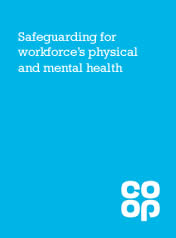Running a business is a round-the-clock operation – and in some sectors, this means working through the night to keep things moving. But antisocial hours can take their toll on people’s health, with night shift workers more likely to struggle with alertness and overall performance.
As an employer, you have a duty of care to look after all staff members, including those on night shifts. How can you set up your business to optimise productivity, but also give teams time to recover? Let’s take a closer look.

Taking night shift challenges seriously
The impact of shift work on people’s wellbeing is a well-documented subject, but companies are now paying closer attention to the care of night staff. For example, Co-op recently announced a new manifesto for safeguarding their workforce’s physical and mental health, after finding that 1 in 3 nightshift workers were getting less than five hours’ sleep per day.
Co-op’s manifesto is based around a set of key principles: recognising and responding to night workers’ needs, respecting the specific challenges they face, implementing evidence-based solutions, and mobilising companies across all industries to develop support programmes. And Co-op wants its manifesto to become a blueprint for nationwide change – so your business can use them as a framework.
Don’t set tough schedules without realising
Listening to and understanding the needs of night workers is one thing; finding practical solutions to support their long-term health is quite another. How can your organisation create a structure that keeps operations running, without causing staff burnout?

The answer lies in effective shift planning. Developing shift patterns that optimise the skills of people on duty, while preventing employees from overworking and tiring themselves out.
Many businesses are currently using manual or outdated systems to compile shift plans, which aren’t set up to analyse staffing patterns or manage tasks. It’s easy to assign a tough schedule of night work to team members without noticing – and they may be too polite to push back.
Updating your shift planning software will help your business to optimise the staff rota for every moment of operation. For night shifts, this means ensuring that essential jobs are carried out in off-peak hours, while minimising the number of people that need to be on duty.
In addition to optimising the schedule, a good shift planner will assign workload in-line with people’s contracted hours, to prevent unnecessary overtime, and help staff to structure their night shift with task planning functionality.
Time off between shifts is just as important
It’s not just the number of hours people work that affects their wellbeing; it’s how long staff are given to rest between shifts as well. With a manual scheduling process, it can be easy to assign staff a sequence of night and day shifts back-to-back, so they’ve got very little time to reprogramme their body clock.
Upgrading your shift planning system can overcome this issue, as you can create best practice patterns for alternate day and night shifts, with a minimum/set number of days off in between. Automating this process means your managers don’t have to manually check whether they’ve given people enough of a gap between shifts; they simply input the correct shift pattern from a series of approved templates that you’ve already created.

Creating protocol around downtime can also help your business plan ahead for peak trading requirements. Once you know everyone’s upcoming schedules and the gaps in between, you can then identify how many temporary staff you will need to support core employees when you’re running at maximum capacity.
Build your night shift manifesto
Night shifts can be tough going, and most employers are incredibly grateful to the staff who work antisocial hours to keep your company running. But gratitude alone is not enough to support their long-term wellbeing.
For true appreciation and duty of care, your business needs to follow in the steps of companies like the Co-op and put a framework in place for safeguarding shift workers’ health. The best manifestos will be backed-up by software that enables your managers to plan shifts better – so that nightshift workers can be productive on the job, but also have time to rest.
WhosOffice can help you optimize staffing levels at all times of day, to run a continuous operation without burning staff out. We’re already helping organisations in 24/7 industries including retail, transport and healthcare to get the best out of their workforce. Get in touch to discuss your shift planning challenges and how we can solve them.
Book your free WhosOffice trial to see how our shift planning software works.
Photo by Fabio Santaniello Bruun, Lianhao Qu of Unsplash.com
FREE TRIAL
Try WhosOffice for free before you sign up – no credit card required
EXPERT SUPPORT
We offer telephone and email support to our customers, at no extra cost
NO CONTRACTS
Cancel when you like with just 30 days’ notice
NO HIDDEN COSTS
We don’t believe in add-on charges or set-up fees


